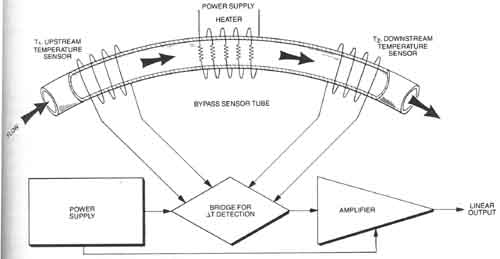AMAZON multi-meters discounts AMAZON oscilloscope discounts
A mass flow meter is one of the most accurate type of flow meters that is designed to measure the flow of gases as well as other fluids. There are two common types of mass flow meters:
- Coriolis mass flow meter (so named because it uses the Coriolis phenomenon
to measure mass flow instead of volumetric flow)
- Thermal mass flow meter
The Coriolis mass flow meter uses a U-shaped tube that is designed to vibrate up and down at its natural frequency while all of the fluid flows through it. A strong magnet is used to make the U-tube vibrate. ill. 1 shows an example of the Coriolis mass flow meter in three distinct stages. ill. 1a shows the tube when it's not vibrated, and ill. 1b shows the tube as it vibrates. These two diagrams show that when the U-tube vibrates it will naturally move up and down. When fluid is flowing through the tube, it will oppose the up-and-down movement, which will cause the U-tube to twist. ill. 1c is an end view of the U-tube and it shows the effect of the twisting motion. The amount of twist will be directly proportional to the amount of flow. Sensors are located near the tube to detect the amount of twist and convert it to a usable variable-voltage signal. This type of mass flow meter is useful to measure fluids whose viscosity continually changes because they don't need to have pressure or temperature compensation.
The thermal mass flow meter can be used for measuring the mass flow of gases. This type of mass-flow meter uses a thermal element whose temperature changes as fluid flows past it. The amount of heat loss is directly proportional to the fluid flow. The thermal element is mounted close to the fluid flow (though it not come directly into contact with the fluid). This allows this type of mass flow meter to be used in virtually all types of applications where the density, pressure, and viscosity may change. The flow meter uses an electronic package that contains a flow analyzer, temperature compensator, and a signal conditioner to provide a linear output signal. ill. 2 shows a diagram of a thermal mass flow meter.

Above: ill. 1 (a) The U-tube portion of a Coriolis mass flow meter. All
fluid flow will travel through the U-tube portion of the flow meter. (b)
This diagram shows the U-tube vibrating up and down. The up-and-down movement
is caused by a magnet. (c) This diagram shows an end view of the U-tube.
When fluid is flowing through the U-tube as it vibrates, the tube will
tend to flex.

Above: ill. 2. A thermal mass flow meter (from Omega Engineering) that
shows the thermal element directly below the flow passage. Notice that
the fluid flow does not come directly into contact with the thermal element,
but it's close enough to provide heat transfer.